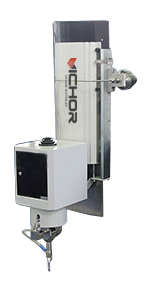
4 Axis Waterjet: Unlock Complex Parts & Precision Bevel Cutting for Manufacturing
For decades, standard 3-axis waterjets have been the workhorses of precision cold cutting, renowned for slicing intricate 2D shapes from virtually any material. But what happens when your project demands more than a flat profile? When you need a precise beveled edge for welding, a chamfer for safety, or complex 3D contours? Enter the transformative technology of 4 axis waterjet cutting. This advanced capability elevates waterjet machining from simple profiling to sophisticated fabrication, unlocking new design possibilities and eliminating costly secondary operations. This comprehensive guide explores the world of 4 axis waterjet systems, detailing their unique advantages, applications, and critical considerations.
What is 4 Axis Waterjet Cutting? Understanding the Mechanics
At its core, a 4 axis waterjet system builds upon the standard 3-axis (X, Y, Z) foundation. The three primary axes allow the cutting head to move horizontally across the material (X and Y) and vertically to adjust the height above the workpiece (Z). The revolutionary fourth axis, typically referred to as the “A-axis” or tilt axis, adds rotational movement to the cutting head itself.
The Tilt Mechanism: This fourth axis allows the cutting head to tilt dynamically, typically up to 45-60 degrees (depending on the machine) from vertical (0 degrees), in either direction (± A-axis). This tilt happens while the head is moving along the X, Y, and Z paths.
Synchronized Motion: The key to 4 axis waterjet precision is the real-time synchronization of the tilt angle (A-axis) with the linear motion (X, Y, Z). Sophisticated CNC controllers and CAM software calculate the precise angle needed at every point along the cutting path to achieve the desired edge geometry.
Purpose: The primary purpose of the A-axis tilt is to compensate for the inherent “lag” or “trailback” of the abrasive waterjet stream. In a vertical cut, the jet exits the nozzle perpendicularly. However, as the jet cuts through material, it naturally erodes slightly slower on the leading edge and faster on the trailing edge due to the abrasive particle dynamics, resulting in a slight taper (usually a few degrees). The 4 axis waterjet dynamically angles the entire head to intentionally pre-tilt the jet, counteracting this natural taper and producing a truly square edge, or deliberately creating a specific, precise bevel angle.
The Power of Beveling: Eliminating Secondary Operations
The most significant and immediate benefit of 4 axis waterjet technology is its ability to produce precise, clean beveled edges directly in a single setup, eliminating the need for time-consuming and expensive secondary machining operations.
Weld Preparation: This is the dominant application. 4 axis waterjet systems excel at cutting precise weld preparation bevels (V-grooves, J-grooves, U-grooves, compound angles) on plate edges. This ensures perfect fit-up for welding, leading to stronger, higher-quality welds and significantly reducing pre-weld labor (grinding, milling, manual beveling).
Chamfering: Creating consistent, precise chamfers (angled edges) for deburring, safety (removing sharp edges), aesthetic purposes, or facilitating assembly.
Complex Edge Profiles: Beyond simple straight bevels, advanced 4 axis waterjet systems can create complex contoured bevels, where the bevel angle changes dynamically along a curved cutting path. This is essential for parts like turbine blades, complex manifolds, or sculptural elements.
Taper Compensation for Precision: Even when a perfectly square edge is required (e.g., for precision mating surfaces), the 4 axis waterjet uses its tilt capability to actively compensate for the jet’s natural taper, achieving near-vertical walls (±0.1 degrees or better) through thick materials – something impossible for a standard 3-axis jet.
Time & Cost Savings: Eliminating secondary beveling operations drastically reduces part handling, setup time, labor costs, and potential for errors or damage during transfer between machines. It streamlines the entire fabrication process.
Material Versatility & Thickness Advantages Amplified
Standard waterjets are already celebrated for cutting almost any material. 4 axis waterjet capability significantly enhances this versatility, particularly for thick sections and challenging materials where edge quality and precise angles are critical.
Thick Plate Mastery: Beveling thick plate (over 1 inch / 25mm) with traditional methods (milling, grinding) is slow, expensive, and generates significant heat and stress. 4 axis waterjet handles thick stainless steel, titanium, Inconel, aluminum, and armor plate efficiently, producing cool, stress-free bevels with excellent surface integrity. Capabilities often extend to 6-12 inches (150-300mm) or more.
Heat-Sensitive & Exotic Alloys: The cold-cutting nature of waterjet is paramount for materials like titanium, hardened tool steels, and heat-treated alloys where traditional thermal beveling methods (plasma, laser, oxy-fuel) would destroy material properties or create heat-affected zones (HAZ) prone to cracking. 4 axis waterjet preserves the metallurgy.
Composites & Laminates: Cleanly beveling composite materials (carbon fiber, fiberglass) or laminates without delamination, fraying, or heat damage is a major challenge. The cold, mechanical erosion of a 4 axis waterjet provides an excellent solution.
Stone, Glass & Ceramics: Creating precise beveled edges or miters on stone countertops, thick glass sections, or technical ceramics for architectural or industrial applications, avoiding chipping or thermal shock.
Multi-Layer & Dissimilar Materials: Cutting and beveling stacks of different materials simultaneously.
3-Axis vs. 4-Axis Waterjet Capability Comparison
| Feature | 3-Axis Waterjet | 4 Axis Waterjet |
|---|---|---|
| Axes of Motion | X, Y, Z (Linear) | X, Y, Z, A (Linear + Head Tilt) |
| Primary Output | 2D Profiles (Flat Parts) | 2D Profiles + Precise Bevels/Chamfers |
| Edge Taper | Natural Taper (1-4° typically) | Compensated (Square Edge) OR Controlled Bevel |
| Weld Prep Ability | Limited (Requires secondary ops) | Yes – Direct, Precise Bevels in One Setup |
| Complex Contour Edges | No | Yes – Dynamically Angled Edges on Curves |
| Thick Material Edge Quality | Tapered Edge | Superior Square or Angled Edge |
| Secondary Operations | Often Required (Milling, Grinding) | Significantly Reduced or Eliminated |
| Cost & Complexity | Lower | Higher (Machine, Software, Operation) |
Enhanced Precision & Complex Geometries
Beyond beveling, the dynamic tilting capability of a 4 axis waterjet enables new levels of precision and the fabrication of complex geometries previously impractical or impossible with standard waterjets or other processes.
True Near-Net-Shape Cutting: By compensating for taper, parts come off the 4 axis waterjet with final-dimension edges, especially critical for thick parts requiring tight tolerances on wall perpendicularity or mating surfaces. This reduces or eliminates finish machining.
3D Contouring: While not a full 5-axis system for freeform 3D sculpting, 4 axis waterjet can machine relatively simple 3D contours and angles on plate edges or create tapered features. The tilt axis allows the jet to follow non-vertical paths across the material surface.
Undercutting & Features: The angled jet can be used to create undercuts or specific internal features that a purely vertical jet could not achieve without complex multi-pass strategies.
Improved Kerf Control: Advanced control over the jet angle can help optimize kerf width consistency in challenging materials or intricate details.
Reduced “Dwell” Marks: Dynamic head tilting during piercing and cutting transitions can help minimize marking on the material surface compared to purely vertical approaches.
Software & Programming: The Brains Behind the Motion
Harnessing the full power of a 4 axis waterjet relies heavily on sophisticated Computer-Aided Manufacturing (CAM) software. This is significantly more complex than programming a standard 3-axis jet.
CAD Model Import: Work typically starts with a 3D CAD model of the final part, including the desired bevel angles or edge geometries.
Feature Recognition: Advanced CAM software can automatically recognize edges requiring bevels based on user-defined rules (e.g., “bevel all external edges at 37.5 degrees”).
Toolpath Generation with Tilt Calculation: The core function. The CAM software calculates the precise synchronized path for X, Y, Z, and A-axis movement. It factors in:
The desired final edge geometry (bevel angle, land).
The material type and thickness.
The inherent characteristics of the waterjet stream (kerf width, taper characteristics, cutting speed).
Machine kinematics (limits of tilt angle, acceleration).
Simulation & Verification: Crucial step. Software provides realistic simulation of the entire cutting process, showing the jet path, tilt angle changes, and potential collisions with fixtures or the machine itself. This allows programmers to verify the toolpath before running expensive material.
Post-Processing: Translates the CAM toolpath into the specific machine code (G-code) understood by the 4 axis waterjet’s CNC controller.
Operator Expertise: Programming and operating a 4 axis waterjet requires a higher skill level than a 3-axis machine. Understanding machining principles, material behavior, and complex CAM software is essential.
Applications: Where 4 Axis Waterjet Shines
4 axis waterjet technology finds its strongest value proposition in industries demanding high-precision parts with complex edge requirements, particularly in thick materials:
Aerospace & Defense: Critical weld prep on airframe components (spars, ribs, bulkheads), engine parts, landing gear components, armor plate beveling. Handling titanium, Inconel, high-strength aluminum.
Heavy Machinery & Construction Equipment: Large weldments, structural components, buckets, booms requiring precise bevels for high-strength welds on thick plate (A36, AR400, Hardox).
Energy (Oil & Gas, Nuclear, Wind): Pressure vessel components, flanges, pipe fittings, valve bodies, wind turbine structural parts. Beveling exotic alloys and thick sections under stringent quality requirements.
Marine & Shipbuilding: Hull plates, frames, structural members requiring bevels for welding. Cutting thick plate with precision.
Architectural Metalwork: Complex decorative panels, sculptures, stair stringers, railings requiring precise mitered or beveled joins in stainless steel, bronze, or other metals.
Precision Fabrication Shops: Job shops specializing in complex, high-value parts where eliminating secondary ops provides a competitive edge and higher margins.
Tool & Die: Creating mold plates, die components with precise shutoff angles or tapered features.
Considerations & Challenges
While powerful, implementing 4 axis waterjet technology involves significant considerations:
Higher Capital Investment: 4 axis waterjet systems are substantially more expensive than comparable 3-axis machines due to the complex tilt head mechanism, robust CNC controls, and sophisticated software.
Increased Operating Costs: Consumable costs (abrasive, nozzles, seals) remain similar, but the complexity may require more advanced maintenance and potentially higher skilled labor costs.
Software Cost & Complexity: The specialized CAM software required is a significant investment and demands trained programmers.
Programming Time: Generating verified 4-axis toolpaths takes considerably longer than programming simple 2D profiles. This impacts throughput for simple jobs.
Slower Cutting Speeds: Bevel cutting, especially at steep angles or in thick materials, is significantly slower than straight vertical cutting. Dynamic tilting also requires careful control of acceleration/deceleration.
Material Handling: Cutting thick plate at an angle can induce different stresses; robust fixturing is crucial. Handling very large, heavy plates adds complexity.
Operator Skill Requirement: Finding and training operators/programmers capable of maximizing the machine’s potential is essential and can be challenging.
The Future of 4 Axis Waterjet
The technology continues to evolve:
Improved Speed & Efficiency: Developments in pump technology (higher pressures, more stable), abrasive delivery, and nozzle design aim to increase bevel cutting speeds.
Smarter CAM Software: Enhanced automation in feature recognition, tilt angle optimization, and collision avoidance, making programming faster and more accessible.
Integration with Automation: Increased integration with robotic material handling systems for lights-out operation of complex beveling jobs.
Hybrid Machining: Combining 4 axis waterjet (for roughing and beveling) with other processes like milling (for finishing critical surfaces) on a single platform.
The 4 axis waterjet is not a replacement for the standard 3-axis machine; it’s a specialized, high-value tool targeting specific, demanding applications. Its core strength lies in its unparalleled ability to produce precise, complex beveled edges and taper-compensated cuts in thick, challenging materials, all within the cold-cutting, stress-free, versatile waterjet process.
The decision to invest hinges on your specific part mix. If you regularly fabricate thick plate components requiring weld prep, precise chamfers, or complex edge geometries, and you are burdened by the cost and time of secondary beveling operations, a 4 axis waterjet can offer a compelling return on investment through dramatically reduced part handling, eliminated machining steps, faster overall throughput for complex parts, and superior edge quality. However, the significant upfront cost, software complexity, and need for skilled operators demand careful evaluation. For shops operating in high-value manufacturing sectors like aerospace, energy, and heavy equipment, the 4 axis waterjet is rapidly transitioning from a luxury to a necessary competitive advantage, unlocking a new level of integrated fabrication capability.
continue reading



